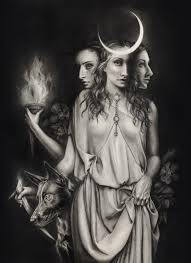A handy key to the herbs of witchcraft. Each of the herbs listed has its own character and magickal properties. They are revealed to the Witch through study, meditation, and practice.
For this glossary, we’ve limited the description of each herb to a few words. Many herbs have their own articles with more in-depth information, in case you wish to learn more.
Here are the suggested meanings and uses of some popular ritual herbs:
Agrimony – ancient herb of healing, restoration, and benevolent protection
Alfalfa – good fortune, money magick, healing and cleansing infusions
Angelica – warding and banishing, angelic magick, summoning strength
Astragalus – vital energy, protection (shielding), promoting health, mental clarity, concentration
Basil – blessings, love, money, and happiness
Bay Leaf – confers wisdom, strength, and visions, sacred herb of Apollo
Bearberry – psychic awareness, dreams, courage, smudging and offerings
Birch Bark – new beginnings, psychic protection, strength, devotion, the Goddess
Blessed Thistle – consecration, protection, healing and cleansing by fire
Blue Sage – smudging, meditation, relaxation, ancestral wisdom, peace
Blue Vervain – spells of love and advancement, astral travel, initiation
Burdock Root – warding, cleansing, uncrossing and counter-magick
Calendula – solar rites, divination, remembrance, honoring the dead
Catnip – love-drawing, relaxation, trance work, feline magick
Cedar – ancient wisdom, protection, maturity, strength and power
Cinnamon – passion, shielding, quick success, spirit evocation, fire magick
Cinquefoil (Five Finger Grass) – for the five blessings: health, money, love, power, and wisdom
Coltsfoot – divination, visions, love magick, healing from within
Comfrey – healing, restoration, lucky herb of travelers and gamblers
Damiana – lust, sex magick, psychic abilities, energy work, spirit quests
Dandelion – wishes, divination, calling spirits, charisma and success
Devil’s Claw – protection, exorcism, banishing spells, keeping away evil, confounding enemies
Dill – sexual love, luck, protection against sorcery and disease
Dittany of Crete – rare herb from Greece, renowned for love magick, manifestation, spirit contact
Elderberry – hidden wisdom, Crone magick, banishing, Faery offerings
Eucalyptus – cleansing, healing, ritual baths, rites of Mercury and Air
Fennel Seed – psychic protection, counter-magick, confidence and adaptability
Feverfew – humble flower renowned for its curative properties, a magickal “fix-all”
Galangal – strength and power, victory, luck, hex-breaking, male potency
Ginger – fiery herb of passion, success, and personal power
Hawthorn Berry – fidelity, shielding, clarity, ancestor and Faery magick
Hibiscus – love and passion, independence, confidence
Horehound – mental clarity, dispelling illusion, quick action, healing
Hyssop – purification, innocence, blessings, sacred baths and washes
Irish Moss – financial luck, folk remedies, safety during travel, sea magick
Jasmine – love, dreams, divination, sensuality, luxury and kindness
Juniper Berry – good luck, prosperity, masculine energy, protection at home
Juniper Leaf – purification, protection, bringing luck, exposing truth
Lavender – love and attraction, purification, relaxation, restful sleep
Lemon Balm – tranquility, attraction, fidelity, teamwork, harmonious home
Lemon Peel – cleansing, purifying, boosting energy, sweetness and charm
Licorice Root – domination, advantage over others, passion, power, persuasion
Lobelia – spirit communication, love and weather magick, trance, blessings and curses
Mandrake – legendary magickal herb for love magick, protection, and curses
Marjoram – protection, married love, calming the mind, easing grief
Marshmallow Root – love charms, psychic powers, protection, drawing good spirits
Meadowsweet – sacred flower of Spring, the Maiden, and the Underworld
Mistletoe – good luck, love and money spells, many traditional charms
Mugwort – scrying, divination, psychic ability, lucid dreaming, Lunar magick
Mullein – protection, illumination, courage, hedge-crossing, Crone magick
Nettle – courage, consecration, protection, healing, deterring evil
Orange Peel – uplifiting and centering Solar herb of joy, blessings, and good luck
Orris Root – charms of love, persuasion, popularity, charisma and success
Patchouli – love and sex magick, attraction, fertility, rites of Earth
Pennyroyal – calmness, endurance, patience, dispelling anger, warding
Peppermint – healing, purification, psychic awareness, love and energy
Pine – persistence, moderation, prosperity, and good health
Raspberry Leaf – love and enjoyment, tempting others, divination
Red Sandalwood – used in incenses for meditation, healing, and trance work
Rose – charms of love and beauty, harmony, divination, Goddess rites
Rosemary – cleansing, purification, vitality, wisdom, protection
Rue – warding, exorcism, cleansing, love-drawing and protective charms
Spearmint – love, psychic ability, cleansing, renewal, house blessing
Star Anise – clairvoyance, good luck, psychic dreams, travel charms
Thyme – beauty, strength, courage, a favorite herb of Faeries
Valerian – warding, enemy spells, transmuting negativity, feline magick
Vervain – Old World herb of wisdom, healing, and second sight
White Sage – cleansing, house blessing, meditation, healing
White Willow Bark – solace, wisdom, long-lasting love, divination, Lunar magick
Wild Lettuce – visions, trance, dream magick, enthrallment and sleep
Witch Hazel – comfort and healing, wisdom, protection, soothing of anger
Wood Betony – herb of St. Bride, used in charms against ill luck, anxiety, and despair
Wormwood – psychic vision, spirit evocation, hexes and curses, reversal magick
Yarrow – ancient medicinal flower used for courage, divination, good fortune








